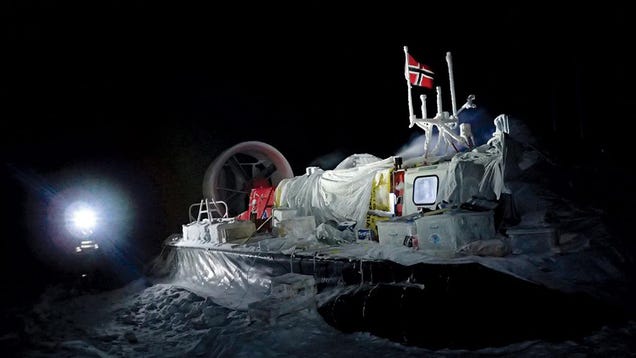Two Norwegian scientists are on the expedition of a lifetime in the Arctic Ocean. The two men – 73-year old Yngve Kristoffersen and his partner Audun Tholfsen – have been exploring the mostly-unknown region of the world between Canada and Greenland aboard a hovercraft since last August, braving extreme cold, inhospitable weather, and months without sunlight for their research.
The 18-month long project has a number of goals, not the least of which is mapping a massive deep-sea ridge that runs from Ellesmere Island all the way to the North Pole. But they are also searching for a large meteorite that is believed to have crashed into the ice millions of years ago, as well as conducting research into what the Arctic was like back then, when the water was much warmer, and unique species of sea turtles and crocodiles lived there.
The two men have been living in a small hovercraft for the past four months, using it not only as their means of transportation, but also as a mobile research lab. The hovercraft is a vehicle that is well suited for travel in the Arctic, where the ice can get so thick at times that only specially equipped ice breakers are capable of breaking through. Riding on a cushion of air generated by two large turbines, their sturdy craft glides along above the ice however, rarely encountering any surface conditions hat it can’t maneuver over or around.
The scientists will often park the hovercraft on an ice flow and stay stationary for days while they take samples of the ice and record atmospheric conditions. At other times, they’re on the move, off to another location to explore a new area of the Arctic. As they go, they have witnessed the way the ice moves, breaks apart, and shifts, giving them a rare glimpse of the powerful forces that are at work at the top of the world. During their time exploring this part of the world, they have discovered indications of a tectonic fault line in the region and spotted a strange new species of fish that resembles an eel living in the cold mud of the sea floor. They have even stumbled across a Russian submarine patrolling the Arctic as well.
In a few months, Tholfsen will be airlifted home and replaced with another scientist, but Kristofferson will stay for the entirety of the expedition. You can follow their ambitious mission at the expedition’s official website, which has more information about their goals, and regular updates on the team’s progress as well.
- Gear Review: The Xero Scrambler Mid is an Ultralight Hiking Shoe for Spring - March 1, 2023
- Gear Review: Yeti Roadie 48 Wheeled Cooler - August 18, 2022
- Kristin Harila Continues Pursuit of 8000-Meter Speed Record - August 16, 2022
